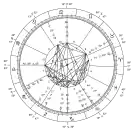Aries (astrology)
Aries (♈︎) (Greek: Κριός [Kriós], Latin for "ram") is the first astrological sign in the zodiac, spanning the first 30 degrees of celestial longitude (0°≤ λ <30°), and originates from the Aries constellation. Under the tropical zodiac, the Sun transits this sign from approximately March 20 to April 20 each year.[2] This time duration is exactly the first month of the Solar Hijri calendar (Arabic Hamal/Persian Farvardin/Pashto Wray).[3]
| Aries | |
|---|---|
 | |
| Zodiac symbol | Ram |
| Duration (tropical, western) | March 20 – April 20 (2022, UT1)[1] |
| Constellation | Aries |
| Zodiac element | Fire |
| Zodiac quality | Cardinal |
| Sign ruler | Mars |
| Detriment | Venus |
| Exaltation | Sun |
| Fall | Saturn |
| Astrology |
|---|
 |
| Background |
|
| Traditions |
|
| Branches |
|
| Astrological signs |
| Symbols |
|
According to the tropical system of astrology, the Sun enters the sign of Aries when it reaches the March equinox, typically on March 21. Because the Earth takes approximately 365.24 days to go around the Sun, the precise time of the equinox is not the same each year, and generally will occur about six hours later from one year to the next until reset by a leap year. The leap day February 29 causes that year's March equinox to fall about eighteen hours earlier compared with the previous year.
Background
Aries is the first fire sign in the zodiac, the other fire signs being Leo and Sagittarius. Individuals born between these dates, depending on which system of astrology they subscribe to, may be called Ariens.[2] The color for Aries is red. [4] In astrology, Aries is the cardinal sign of the fire trigon. It is one of the six positive signs.
The equivalent in the Hindu solar calendar is Meṣa.[5]
Mythology
In Greek Mythology, the symbol of the ram is based on the Chrysomallus, the flying ram that rescued Phrixus and Helle, the children of the Boeotian king Athamas and provided the Golden Fleece.
Gallery

 Mosaic in Maltezana near Analipsi, Astypalaia, 5th century CE
Mosaic in Maltezana near Analipsi, Astypalaia, 5th century CE Aries zodiac sign, Jantar Mantar, Jaipur, India, 18th century CE
Aries zodiac sign, Jantar Mantar, Jaipur, India, 18th century CE Aries, or al-ħamal, depicted in the 14th/15th century Arabic astrology text Book of Wonders
Aries, or al-ħamal, depicted in the 14th/15th century Arabic astrology text Book of Wonders
See also
- Astronomical symbols
- Chinese zodiac
- Circle of stars
- Cusp (astrology)
- Elements of the zodiac
- History of astrology
References
Citations
- Astronomical Applications Department 2011.
- dictionary n.d., s.v. Aries.
- Atsma 2015.
- Orion 2011, p. 1.
- Raman 2003, pp. 10–19.
Sources
- "Aries". dictionary.com. n.d. Retrieved October 14, 2022.
- Astronomical Applications Department (2011). Multiyear Computer Interactive Almanac. 2.2.2. Washington DC: US Naval Observatory. For time of Sun's entry or exit from a sign, calculate Longitude of Sun, apparent geocentric ecliptic of date, interpolated to find time of crossing 0°, 30°..... For list of vernal equinox dates calculate phenomena: solstices/equinoxes, choosing UT1 and years 1800 through 2050.
- Atsma, Aaron J. (2015). "Chrysomallus". The Theoi Project: Greek mythology.
- Orion, Rae (2011). Astrology for Dummies. Hoboken, NJ: John Wiley & Sons. ISBN 9780470098400.
- Raman, Bangalore V. (2003). Studies in Jaimini Astrology. Motilal Banarsidass. ISBN 978-81-208-1397-7.